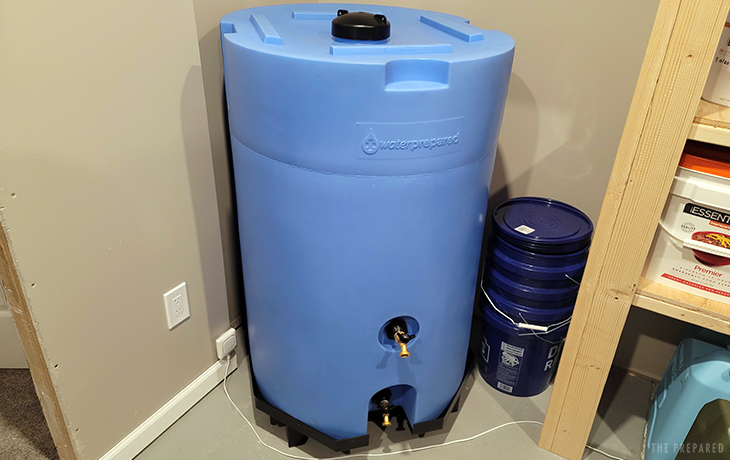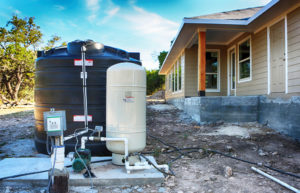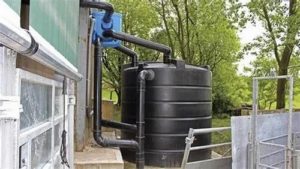When it comes to living off the grid, having a reliable water storage system is essential.
Without access to municipal water supplies, you need a robust tank that can store potable water for your daily needs.
However, not all water storage tanks are created equal, and choosing the right one can be daunting.
We’ll explore the factors to consider when selecting a water storage tank for your off-grid home, from capacity and material to location and maintenance requirements.
By the end of this guide, you’ll have the knowledge you need to make an informed decision and ensure a reliable source of clean drinking water for you and your family.
Determine your water needs
Calculate your daily water usage to determine the right size tank you need. Consider factors such as the number of people in your household, your water usage habits, and the climate you live in.
To calculate your daily water usage, you need to consider several factors such as the number of people in your household, your water usage habits, and the climate you live in.
The number of people in your household is a significant factor in determining your water needs.
A family of four, for instance, would require more water than a single person household.
Similarly, if you have pets, you would need to factor in their water needs as well.
Next, consider your water usage habits.
Do you take long showers or prefer shorter ones?
Do you wash your clothes in cold or hot water?
Answering these questions can give you an idea of how much water you use on a daily basis.
The climate you live in also plays a important role in determining your water needs.
If you live in a hot and dry climate, you may need more water for irrigation purposes, whereas if you live in a cool and wet climate, you may need less water for drinking and household use.
By considering these factors, you can calculate your daily water usage and determine the right size tank you need for your rainwater harvesting system.
For example, if you have a family of four and you live in a hot and dry climate, you may need a tank that can hold at least 2,000 gallons of water to meet your daily needs.
Determining your water needs is a critical step in selecting the right size rainwater harvesting tank.
By considering the number of people in your household, your water usage habits, and the climate you live in, you can calculate your daily water usage and choose the appropriate size tank for your rainwater harvesting system.
Consider the climate
If you live in a hot and dry climate, you may need a larger tank to accommodate for evaporation and water loss. In contrast, if you live in a cooler and wetter climate, a smaller tank may be sufficient.
When choosing a tank size for your aquarium, it’s essential to consider the climate in which you live.
If you reside in a hot and dry climate, you’ll need a larger tank to accommodate for evaporation and water loss.
This is because hot and dry climates have a higher evaporation rate, which means more water will be lost from the tank through evaporation.
In contrast, if you live in a cooler and wetter climate, a smaller tank may be sufficient.
This is because cooler and wetter climates have a lower evaporation rate, which means less water will be lost from the tank.
If you live in a hot and dry climate, you may need to consider using a tank with a built-in overflow or a sump system to help manage the increased water loss.
This will help to ensure that your aquarium remains healthy and thriving, regardless of the climate you live in.
Choose the right material
Water storage tanks come in different materials such as plastic, fiberglass, and metal. Plastic tanks are lightweight and affordable, while metal tanks are more durable but heavier. Fiberglass tanks offer a good balance between the two.
When selecting a water storage tank, choosing the right material is a critical decision that can impact the tank’s performance, durability, and cost.
Plastic tanks are a popular choice due to their lightweight and affordable nature, making them ideal for smaller applications or those with limited space.
However, they may not be as durable as other materials and may be more prone to degradation over time.
Metal tanks, on the other hand, offer superior durability and can withstand harsh weather conditions, but they are heavier and more expensive.
Fiberglass tanks provide a happy medium, offering a balance between the lightweight and affordable qualities of plastic tanks and the durability and longevity of metal tanks.
Fiberglass tanks are resistant to corrosion and can withstand extreme temperatures, making them an excellent choice for various applications.
Ultimately, the right material for your water storage tank will depend on your specific needs and preferences.
It is essential to consider factors such as the tank’s intended use, location, and maintenance requirements before making a final decision.
Think about the location
The location of your tank is important. It should be placed in an area that is easily accessible for maintenance and cleaning, and preferably in a shaded area to reduce algae growth.
When setting up your aquarium tank, it’s essential to consider the location carefully.
The tank should be placed in an area that is easily accessible for maintenance and cleaning.
This will ensure that you can clean the tank and perform water changes conveniently and without hassle.
Placing the tank in a shaded area can help reduce algae growth, which can be a common problem in aquariums.
Algae can grow rapidly in direct sunlight, so by placing your tank in a shaded area, you can reduce the amount of algae that grows in your tank.
This will not only keep your tank looking clean and clear but also ensure that your fish and other aquatic inhabitants remain healthy.
By placing your tank in a well-ventilated, shaded area, you can create a stable and healthy environment for your aquatic pets.
Consider the cost
Water storage tanks can be expensive, so it’s essential to consider your budget and choose a tank that fits within it. However, keep in mind that a more expensive tank may be more cost-effective in the long run if it requires less maintenance and lasts longer.
When it comes to selecting a water storage tank, it’s essential to consider the cost.
Water storage tanks can be quite expensive, with prices ranging from a few hundred dollars for a small, prefabricated tank to several thousand dollars for a large, custom-made tank.
However, while the initial cost may be a significant factor in your decision, it’s important to also consider the long-term costs of ownership.
A more expensive tank may require less maintenance and last longer, which can ultimately save you money in the long run.
For example, a high-quality, prefabricated tank may cost more upfront, but it may require less maintenance and last longer than a cheaper, DIY tank.
This means that you’ll save money on repair and replacement costs over time.
A high-quality tank may be more energy efficient, which can help you save money on your water bills.
Therefore, when considering the cost of a water storage tank, it’s essential to think beyond the initial purchase price and consider the long-term costs of ownership.
By investing in a high-quality, prefabricated tank, you may end up saving money in the long run.
Check the certifications
Make sure the tank you choose is certified by a reputable organization such as NSF International or UL. These certifications ensure that the tank meets certain standards for quality, safety, and performance.
When selecting a water tank, it is essential to check the certifications to ensure that you are purchasing a high-quality and safe product.
Look for certifications from reputable organizations such as NSF International or UL.
These certifications ensure that the tank meets certain standards for quality, safety, and performance.
For instance, NSF International certifies tanks for their ability to withstand pressures and temperatures, while UL certifies them for their electrical safety.
By choosing a certified tank, you can be confident that it will perform as expected and provide safe and clean water for your household.
Certifications can also provide peace of mind in case of any issues or defects, as many manufacturers offer warranties and guarantees for certified products.
So, always check the certifications before making a purchase to ensure that you are getting a reliable and safe water tank.
Evaluate the warranty
Check the warranty offered by the manufacturer and the length of coverage. A longer warranty can provide peace of mind and protect your investment.
When evaluating a potential purchase, it is important to consider the warranty offered by the manufacturer.
A longer warranty can provide peace of mind and protect your investment by covering any defects or issues that may arise during the product’s lifespan.
Look for a warranty that covers both parts and labor for a sufficient amount of time, typically ranging from one to five years.
A longer warranty period can give you more time to use the product without worrying about the cost of repairs or replacements.
Some manufacturers offer extended warranties that can be purchased at an additional cost.
These extended warranties can provide even more comprehensive coverage, often including accidental damage and wear and tear.
Before making a purchase, carefully evaluate the warranty offered to ensure that you have the best possible protection for your investment.
Read reviews
Research the tank you’re considering and read reviews from other customers to get a sense of its performance, durability, and maintenance requirements. This can help you make a more informed decision and avoid any potential issues.
Before making a decision on which tank to purchase, it’s important to conduct thorough research and read reviews from other customers to gain valuable insights into its performance, durability, and maintenance requirements.
Reviews can provide you with firsthand experiences and specific details about the tank’s capabilities, such as its fuel efficiency, power, and handling.
Reading reviews can help you identify potential issues or weaknesses in the tank’s design, which can save you time and money in the long run.
By taking the time to research and read reviews, you can make a more informed decision and avoid any potential regrets or problems down the line.
Reading reviews is important before making a decision on which tank to purchase.
Reviews can provide valuable insights into the tank’s performance, durability, and maintenance requirements.
By conducting thorough research and reading reviews, you can identify potential issues or weaknesses in the tank’s design and make a more informed decision.
Reviews can provide specific details about the tank’s capabilities, such as its fuel efficiency, power, and handling, which can help you avoid any potential regrets or problems down the line.
Want More? Dive Deeper Here!
Hey there! If you’re the type who loves going down the rabbit hole of information (like we do), you’re in the right spot. We’ve pulled together some cool reads and resources that dive a bit deeper into the stuff we chat about on our site. Whether you’re just killing time or super into the topic, these picks might just be what you’re looking for. Happy reading!






